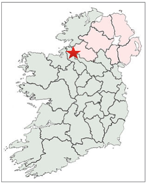
This page contains information on the crosses of County Leitrim. These include cross fragments at Cloone and the Tullaghan or Duncarbry Cross. The location of County Leitrim is indicated by the red star on the map to the right.
Historical Background
County Leitrim is part of the province of Connaught, which traditionally includes counties Leitrim, Sligo, Roscommon, Mayo and Galway. This brief history focuses on County Leitrim up to the end of the period of the High Crosses, about 1200.
Connacht
Pre-historic Connacht was centered around a ritual site at Cruachain Ai, located near Rathcroghan, in County Roscommon. Here the history of human habitation reaches back to at least 2000 BCE. Monuments in the area include sites from the Neolithic (4000-2500 BCE), the Bronze Age (2500-500 BCE) and the Iron age (500 BCE to 400 CE). Tradition states that the area was ruled by the Firbolg until the 4th century CE. At that time peoples from the midlands took control of the area. Two clans, the Ui Briuin and the Ui Fiachrach dominated the area from the 5th to the 12th century.
Kingdom of Breifne
During the 6th century, what is now southern County Leitrim was peopled by the Conmaicne Rein who appear to have moved north from County Galway. Their area became known as Magh Rein and the people became known as the Conmaicne Magh Rein.
About the 8th century the Ui Briuin clans displaced the Conmaicne Magh Rein. By the 9th century the present counties of Leitrim and Cavan formed a part of the Kingdom of Breifne, also known as Ui Briuin Breifne. As the name suggests, they were related to the other Ui Briun clans of Connacht. The ruling clan was the O’Roukes. At times their kingdom included Leitrim and Cavan and parts of Sligo, Roscommon, Longford and even Meath.
In the 13th century Breifne split into West Breifne, ruled by the O’Rourke and East Breifne, ruled by the O’Reilly.
The map above indicates what may have been the greatest extent of the Kingdom of Breifne. (https://en.wikipedia.org/wiki/Kingdom_of_Breifne)
Ecclesiastic History
In the early years of the Christian era in Ireland numerous monasteries were founded, as reported in the List of Monastic Houses in County Leitrim. Below are those that predated the coming of the major orders from the continent in the 12th and 13th centuries. One of these the Drumlease Monastery is credited to St. Patrick. ?t. Patrick is also said to have been involved in the foundation of the monastery at Cloone. Of the sites listed, only one, the Cloone Monastery has fragments of a High Cross. As will be noted below in more detail, there is another High Cross in County Leitrim, located at Tullaghan, along the Donegal Bay. The place of origin of this cross is not known. https://en.wikipedia.org/wiki/List_of_monastic_houses_in_County_Leitrim
Annaduffe Abbeyearly site, founded 766, patronized by Comin Ea (possibly Cuimmin Fionn, Abott ofg Iona)
Cloone Monasteryearly site, founded 6th century by St. Cruimthir Fraech
Drumlease Monasteryearly site, founded 5th century by St. Patrick
Drumreilly Monasteryearly site
Fenagh Monasteryearly site
Killanummery Monastery early site
Killarga Monasteryearly site
Killasnet Monasteryearly site, nuns, founded by St. Osnata
Lough Nahoo Monasteryearly site, founded by 500
Monastery of Mohill-Manchan early site, founded 6th century by St.l Manchan
Rosinverearly site, founded by St.l Maedoc or St. Tighernach
Rossclogher Abbeyearly site, nuns, founded prior to 810 by St. Tighernach, for his mother St. Mella.
Cloone Cross Fragments
From about the first century, Cloone was the center for the Con Maicne tribe. It was known as Cluain Con Maicne or “the fertile meadow of the Con Maicne.” The area had been populated deep into the pre-historic period as testified to by the presence of tombstones from the Bronze Age and a number of megalithic chamber graves.
St. Patrick visited the area and failed to convert the Con Maicne. He did convert a young prince named Fraoch. At some point, Fraoch founded a monastery at Cloone. This saint was known for his wisdom and piety and it is said that even St. Colmcille sought his council and advice. Farce died around 570.
The monastery continued in existence at least into the 12th century as witnessed by an entry in the Annals of the Four Masters that informs us that Muirgeas Ua Muireadhaigh, airchinneach died there in 1101 while on his way to Clonmacnoise.
Cross Fragments
In the area around Cloone there are two high cross fragments and a base. The fragments include a cross-shaft fragment and a cross-head fragment.
Cross-Shaft
The shaft fragment stands about 18 inches (46cm) in height, measures nearly 11 inches (28cm) across and is nearly 8 inches (20cm) thick. (Kelly, p. 156) It is located in a niche in the modern wall of the graveyard at St. James Church in Cloone. (Kelly p. 156) The fragment is part of the upper shaft and it retains indications that it once had a ring. The two faces each bear a figural image.
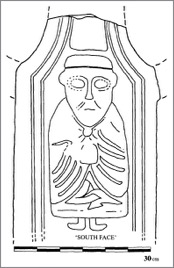

South Face: On the current South face is the figure of an ecclesiastic. He seems to hold something to his chest and it also appears he has something at his neck, perhaps a brooch or neckless. While no identification can be made for certain, this may represent either St. Fraoch the founder of the monastery or St. Patrick who was involved in the establishment of the foundation there. (Grant, p. 17, illustrations right and below left p. 17)
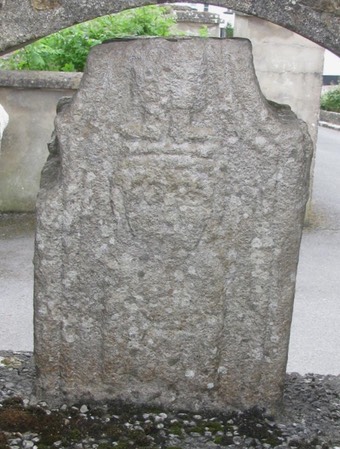
North Face: The figure on the current North face may be either a woman or a man. The figure is seated and like the figure on the South face holds something in its lap. Speculation would suggest a possible identification of the figure as the Virgin and Child or Christ or one of the Evangelists holding their gospel. (Grant, p. 17)
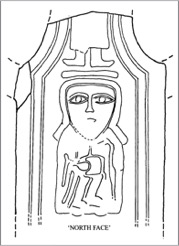
Above this figure on the North face are the feet of another figure. This figure would have been in the center of the head of the cross. (Kelly, p. 156)
Head-fragment
The fragment of a cross-head, comprising the transom of the cross is displayed in the graveyard of St. Mary’s Church in Cloone. The fragment is 10 inches (25.5cm) in height and 30 inches (76cm) across the arms.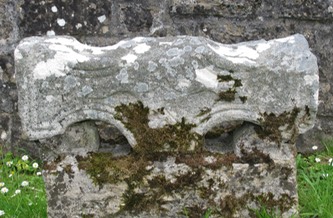
Face A: There is the torso of a robed figure. The head and lower body are missing. The arms extend to either side of the body with the hands spread to show the palms. This seems to be part of the figure on the South face of the shaft described above. It would be consistent with a depiction of the crucifixion. This carving is difficult to make out in the photo.
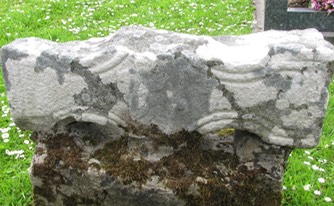
Face B: There is a small figure with an oval face. The crown of the head and lower body are missing. This figure is clothed in stylized drapes and holds a crozier in the left hand. Above the other shoulder is a worn carving that mirrors the position of the crozier head above the opposite shoulder. (Kelly, p. 156) This carving might be consistent with an image of either the Last Judgment or Christ in Glory or it could simply be a bishop or abbot. The figures are impossible to see in the photo.
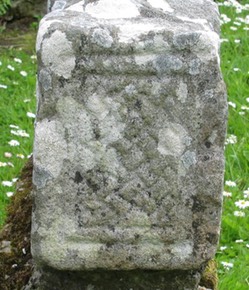
Face C: One end of the arm has a panel of interlace, as shown in the photo to the right.
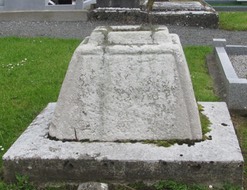
Pyramidal Cross-base
This base is located in the graveyard at St. James’s Church in Cloone. The base is 25 inches (63.5cm) in height and at the base measures 35 inches (89cm) narrowing to 19 inches (48cm)( at the top of the second step. The base has no decoration but is consistent with those associated with a number of Irish High Cross bases. It may well be that the base fits with the cross-shaft and partial cross-head. (Kelly, p. 160)
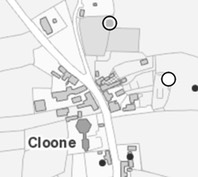
Getting There: See the Road Atlas page 25, D1. Cloone is just north of the R201. There are two locations for crosses as marked on the Historic Environment Viewer. The map is cropped from the Historic Environment Viewer. The uppermost circle is not in the correct place. The cross shaft fragment is in a niche in the wall by the main entrance to the graveyard. The cross-base is toward the center of the graveyard. The lower circle, indicating the cross-head fragment is in a second cemetery, the road to which is just across from the new church. The cross-head is visible through the gates.
Sources Consulted
Grant, Christine, “New Leitrim High Cross”, Archaeology Ireland, Vol. 8, No. 4 (Winter, 1994), pp. 16-17.
Kelly, Dorothy, “Some Remains of High Crosses in the West of Ireland,” The Journal of the Royal Society of Antiquaries of Ireland, Vol. 123 (1993), pp. 152-163.
The Parish of Aughavas and Cloone: http://www.aughavascloone.ie/content.aspx?par=8&ContentId=28
Tullaghan or Duncarbry Cross
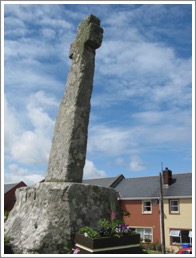
Tradition states the cross was found along the shore of Donegal Bay, north of its present location. No archaeological features have been found in that area. The cross was erected in Tullaghan village in 1778 as noted by an inscription on the base. The intention of Major Dickson, who was responsible for the erection of the cross was to draw attention to the local market which was losing patronage in favor of the nearby Ballyshannon market. Some time later it was moved to its present location on a hillock overlooking the Sligo-Bundoran road.
The area where Tullaghan and the presumed monastery are situated is along a very short stretch of coast where the rivers Duff and Drowse meet the Donegal Bay and form boundaries with County Sligo to the south and County Donegal to the north.
Harbison describes the cross as “A tall, ringless and undecorated cross, with straight arms but an expanding upper limb and a shaft tapering near the top.” (Harbison, 1992, p. 178)
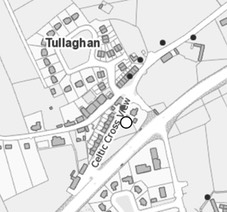
Getting There: See the Road Atlas page 16, E1. Tullaghan is located on the N15 just west of Bundoran. The cross is visible from the highway, on the north side of the road on a rise. The map is cropped from the Historic Envirnoment Viewer.
Resources cited:
Aran Sweaters: http://www.aransweatersdirect.com/blogs/blog/tullaghan-stone-cross
Aidymcglynn: https://aidymcglynn.com/2016/03/04/tullaghan-high-cross/
Megalithicireland: http:??www.megalithicireland.com/Tullaghan%20Cross.html
Historic Environment Viewer: http://webgis.archaeology.ie/historicenviornment/